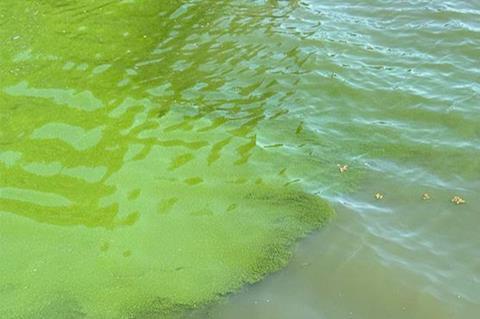A breakthrough study of freshwater harmful algal communities led by Dave Hambright, a Regents’ Professor of Biology at the University of Oklahoma, has discovered that complementary genes in bacteria and algae living in the same algal colonies coordinate the use and movement of nutrients within the colony. This research, funded by the National Science Foundation, has been published in the journal Microbiome.

Cyanobacteria are often called blue-green algae because they use photosynthesis for energy and can form a bluish-green film on the water’s surface when they are abundant. This frequently happens in waters receiving agricultural runoff, fertilizers, and urban wastewater. While naturally present in most lakes, many cyanobacteria can become problematic when they are abundant – that is, when they bloom – because they produce toxins that are harmful to wildlife, aquatic environments, and human health.
Nutrient pollution
“These algal blooms are fueled by nutrient pollution,” Hambright said. “Oklahoma is particularly prone to these harmful algal blooms because our lakes are reservoirs with watersheds that can be hundreds of time times larger than the lake it feeds. Compared to a watershed of a natural lake, like those common in the northern United States with a watershed that is often less than 10 times larger than a lake, the likelihood for nutrient pollution in Oklahoma dramatically increases.”
During their research, Hambright’s team discovered that aerobic anoxygenic phototrophic, or AAP, bacteria were significantly more abundant in cyanobacterial colonies than in the surrounding waters. For years, researchers have hypothesized that there must be a mutually beneficial reason for this cohabitation.
“We know that AAP bacteria need a source of food. The gelatinous matrix of the colony in which the AAP bacteria live provides that food source,” he said. “This research is the first time that we’ve shown distinct, complementary functions between AAP bacteria and cyanobacteria critical to the algal bloom’s existence.”
Coordinating metabolic processes
Hambright’s team studied the genes of the microbiome, or the bacteria that live with the cyanobacteria, from lakes around the world. They examined the genes that use and move sulfur, nitrogen and phosphorus and found that complete metabolic pathways were coded by a combination of some genes in the algae with other genes in the microbiome bacteria.
“No matter what lake the cyanobacterial sample came from, whether from the United States, Europe, New Zealand or China, these ‘helper’ bacteria were doing the same processes for the cyanobacteria,” he said. “This unique discovery suggests that algae and bacteria living in these colonies have a complementary set of genes that allow colony members to coordinate the metabolic processes involved in nutrient cycling within the colony. Our working hypothesis is that the genes present in a particular cyanobacterium determine what the bacteria living in its colony provides.”
Breaking the link
According to Hambright, more research is needed to confirm these findings. Researchers also need to determine if the cyanobacteria require cooperation from the bacteria living with them.
“If validated, perhaps we could find ways to break that collaboration so that the algae don’t thrive and bloom, thus giving other non-harmful algae a chance to compete for nutrients. This would help balance the food web and improve the habitat for fish and other aquatic organisms. It would also lead to better water quality and, thus, a lower treatment cost for drinking water in our state,” he said.







No comments yet